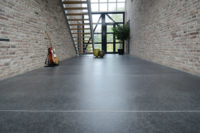No matter the category, technology has been playing a major role in the types of products manufacturers are able to produce, and the tile industry is no different. In fact, many would argue there’s a technological revolution taking place in the category—some would call it an evolution—as companies are creating products with looks and textures never before seen.
Aside from better, high definition visuals, there are two major movements taking place in tile: One is the fact Americans are starting to gravitate to using larger products as seen in other parts of the world (see related story on page 22). The second is that tiles in general are getting thinner. This would almost seem to be in contrast to the first point as one would think as the product got larger is would need to be thicker—or at least maintain its traditional thickness—to meet the extra demands placed on if from the overall size of each tile being bigger.
But in today’s world of modern technology thinner doesn’t mean weaker. In fact, today’s thin tiles can not only stand up to the everyday abuse as their thicker counterparts, in many cases they actually offer a number of additional benefits that, up until now, did not exist within the category. From giving the end user more flexibility in terms of how the tile can be used to allowing manufacturers to save on numerous resources, such as raw materials, and the energy needed to both make and ship the products, there is a reason why thinner tiles are becoming the new norm in the tile segment.
“It has been exciting to observe the changes in the tile industry over the past five years—specifically in terms of product innovation,” said Lori Kirk-Rolley, senior marketing director of Dal-Tile.
When it specifically comes to thin tile, Kristin Coleman, marketing rep for Ceramics of Italy, noted, “It is one of the most versatile products on the market. It has the same advantages as regular porcelain—durable, hygienic, easy to clean, no VOCs—but its slender profile, as thin as 3mm (Editor’s note: that translates into less than .12 inches, slightly under 1/8 of an inch), creates a lightweight and flexible surfacing solution for any flooring project.”
Kirk-Rolley added, “Thin tile continues to gain traction in the tile industry today, and presents a unique opportunity for the marketplace. It allows you to design with the beauty of tile in places where its weight and thickness traditionally limited your options, specifically the wall. The Daltile brand has its own line of thin tile products called SlimLite, which includes porcelain panels as well as slate and quartzite.”
Sean Cilona, Florida Tile’s director of marketing, said thin tiles have been “huge” for its parent company, Italy’s Panariagroup. “It invested in this technology at the start and they even have a factory dedicated to making these types of products.”
He added, at Coverings Florida Tile will be introducing its own line of thin tiles under the umbrella heading, Thinner. “I think we are going to see a whole of bunch of thin tile being introduced to the U.S. market at Coverings.”
Elisa Bellucci, marketing rep for Italian manufacturer Lea Ceramiche, said thin tiles, such as the company’s Slimtech collection, are especially useful for renovations “where they can be installed over existing surfaces. The thin slabs can be glued directly onto the old surface, avoiding demolition costs and reducing installation time.”
Lee Hojin, product and marketing director for Eleganza Tile of Anaheim, Calif, an exclusive distributor of Slimtech, told Floor Trends’sister publication, Tile, he believes the environmental movement is pushing the popularity of thin panels—especially the larger ones for a number of reasons. “The weight of the product is resulting in fuel efficiency. You can load more than 44,000 square feet [of large thin porcelain panels] verses 11,000 square feet [of thicker material]. That’s a huge difference.
His second green factor is “existing tile doesn’t have to be torn out. It saves time and money, as the existing material doesn’t have to be put in a landfill.”
In fact, while today’s thinner tiles can be installed over existing surfaces, including concrete, ceramic, wood, metal, plywood, fiberglass, backer board, tile, dry wall, painted surfaces, door skins, cabinetry columns and more.
Ryan Fasan, technical consultant to the Tile of Spain, said, “There are so many reasons slim porcelains make sense—reduction in resources required, reduction in product and shipping emissions and easier maneuverability and cutting on jobsites to name a few.”
However, he added, as with anything new there is always trepidation about performance. “The fact is that today’s slim porcelains are, by and large, more impact and bending resistant than traditional thickness materials. Each factory has its own method to increase technical aspects of their slim tile but the truth is, for light commercial and residential applications slim porcelains are a fantastic option.”
Tim Bolby, Crossville’s executive director of technical services, added, like any product “correct technical specifications and installation are key to ensuring lean profile, porcelain panels perform properly.”
In line with what Fason said, Bolby pointed to the way Laminam by Crossville 3+ panels (3mm thick) are constructed to give them the necessary strength to perform. “It has a fiberglass mesh backing to heighten strength and is even suited for interior vertical installations. Because of the lean profile, these panels can be used in ways traditional tile couldn’t—yet they perform reliably because they’re engineered for strength. For interior floors, we have Laminam 5.6 collections. The slightly increased thickness of 5.6mm meets specification requirements for floor installations.”
Daniel Sanchez, sales director for TheSize, said the company’s Neolith brand uses a technique called “sinterization. This is a process using high-pressure—up to 400 bars—and high-temperature to create slabs that are noticeably thinner than many other flooring products—less than .2 inches versus more than ¾ inches. Although the slabs are thinner, they have incredibly high durability, exceeding ASTM C648-04.”
He added, the 5mm thick slabs can also be placed directly on existing flooring, in a tile-over-tile application, thus “removing the need for costly gut remodels while cutting down considerably on the time, costs and waste associated with the project.”
Santiago Manent, Porcelanosa USA’s sales and marketing director, agrees thinner doesn’t mean weaker. A thinner tile achieves the same strength and has more competitive and sustainable transportation, benefiting the end client.”
It is for these reasons, he added, the company has moved from a standard ½-inch thickness to 3/8-inch for standard wall tiles. He pointed to the company’s XLIGHT collection as “a great example of this trend. The porcelain tile is characterized by its extra-large format and minimum thickness. XLIGHT is the natural evolution of ceramic in a slab size (120 x 40-inches), a unique large format with a minimum thickness (1/8-inch), and an even lighter weight. This material offers a multitude of possibilities and is suitable for new projects or refurbishing. In addition, it can also be used to over existing tile installations.”
Regardless of the product’s size, thickness, construction, etc., Grant Huffine, senior market manager for H.B. Fuller Construction Products, manufacturer of TECbranded products, said it still comes down to installing it properly in order for it to succeed. “Although large thin panels have become increasingly popular, their successful installation requires specific materials. With the right products, thin tile can succeed in demanding commercial environments. Because of the size and fragility of large thin panels, their installation necessitates latex/polymer modified portland cement mortars, which have greater bond strength and resistance to impact.”
He pointed to the fact TEC not only has a dozenproducts, including surface preparation materials, mortars, grouts and caulks, that have been qualified for use with large thin porcelain panels, some manufacturers such as Crossville “have endorsed them for use with its Laminam line of large thin porcelain panels.”
Because these types of products are still relatively new to the market Crossville’s Bolby said it’s all about education and training to ensure retailers and contractors know how to install these products so they perform to their fullest abilities.As such, the company “conducts installation workshops nationwide, giving contractors firsthand experience working with this category of products that’s rapidly growing in popularity.”













